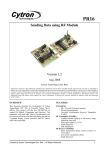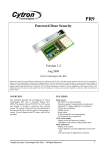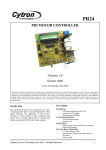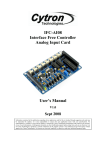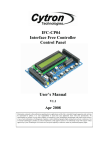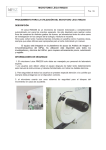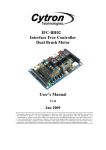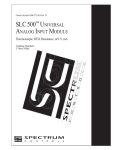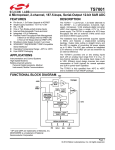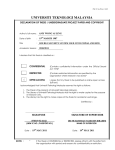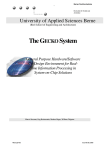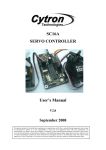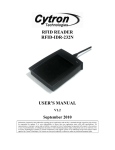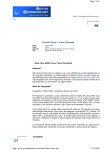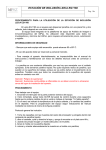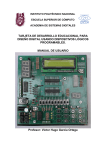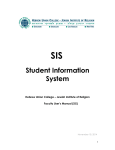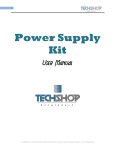Download RFID: Read and Display
Transcript
PR8 RFID: Read and Display Version 1.2 Aug 2008 Cytron Technologies Sdn. Bhd. Information contained in this publication regarding device applications and the like is intended through suggestion only and may be superseded by updates. It is your responsibility to ensure that your application meets with your specifications. No representation or warranty is given and no liability is assumed by Cytron Technologies Incorporated with respect to the accuracy or use of such information or infringement of patents or other intellectual property rights arising from such use or otherwise. Use of Cytron Technologies’s products as critical components in life support systems is not authorized except with express written approval by Cytron Technologies. No licenses are conveyed, implicitly or otherwise, under any intellectual property rights. OVERVIEW FEATURES This document describes the development of Cytron Technologies DIY (Do It Yourself) Project No.8 (PR8). This project will use PIC16F876A and a RFID reader (IDR-232) to control LCD (2x 16 characters), LED and buzzer. Circuit schematic and PIC source code will be provided. PIC16F876A - 8-bit microcontroller with 22 I/O - Operate with 5V supply - Operating speed 20MHz RFID reader IDR-232 - RFID tag reader with serial UART output - Operate with 5V supply - Output baud rate 9600bps LCD (2x 16 characters) - 2x16 character display - Operate with 5V supply - Back light Created by Cytron Technologies Sdn. Bhd. – All Rights Reserved 1 ROBOT . HEAD to TOE PR8 – RFID: Read and Display SYSTEM OVERVIEW RFID tag RFID reader (IDR-232) LCD (2x16 character) Microcontroller (PIC16F876A) Buzzer When the RFID tag is place near the RFID reader, the RFID reader read the RFID tag, further sends the tag ID to the PIC microcontroller. PIC microcontroller process the tag ID, the user name and the tag ID will be display on the LCD display GENERAL DESCRIPTION Specification: Cytron Technologies offers several model of RFID reader. The most common and easy to use reader is IDR-232. It read the RFID passive tag and sends the tag ID to PC or Microcontroller in serial communication. IDR-232 is plug and play RFID reader. It has been designed with capabilities and features of: RFID Reader (IDR-232) • • • • • • • • • • • • • Low cost solution for reading passive RFID transponder tags. Industrial grade casing for better outlook and protection. Integrated RFID reader, antenna, LED, power cable and data cable. Every reader has been tested before it being shipped. 9600 baud RS232 serial interface (output only) to PC. Fully operation with 5VDC power supply. Buzzer as sound indication of activity. Bi-color LED for visual indication of activity. Standard RS232 serial cable (female) ready to plug to desktop PC or Laptop. PS2 as power source from desktop PC. 2cm reading range. 0.1s response time. Operating frequency: 125 KHz IDR-232 is fully working RFID tags reader and can be applied in: • • • • • Figure 1 Security system. Car parking. Office. Hypermarket for item pricing. Student projects. IDR-232 can be connected to PC or microcontroller as part of embedded system. In this project the reader will Created by Cytron Technologies Sdn. Bhd. – All Rights Reserved 1 ROBOT . HEAD to TOE PR8 – RFID: Read and Display be interface to a microcontroller. For more information, please refer: http://www.cytron.com.my/datasheet/IDR232%20Man ual%20v1.pdf How RFID works: RFID also known as Radio-frequency identification is an automatic identification method where the data is stored in the RFID tag. The RFID reader is a device that transmit radio frequency when powered ON. When the RFID tag is place near the RFID reader, the RDIF tag will receive the radio frequency via the antenna inside RFID tag. The radio frequency received will be converted into electrical power that is enough for the RFID tag to transmit the data back to the RFID reader. Further, the RFID reader will transmit the tag ID to PIC or PC via serial communication. PIC16F876A This powerful (200 nanosecond instruction execution) yet easy-to-program (only 35 single word instructions) CMOS FLASH-based 8-bit microcontroller packs Microchip's powerful PIC® architecture into an 28-pin package and is upwards compatible with the PIC16C5X, PIC12CXXX and PIC16C7X devices. Feature of the device: • • • • • • • • HARDWARE This project will require following hardware: a. b. c. d. e. 1 x RFID reader, IDR-232 1 x PR8 Printed Circuit Board (PCB) 1 x PIC16F876A 1 x LCD (2x16 character) Related electronic components Please refer to Appendix A for the PCB layout of PR8. The PCB layout is provided free therefore Cytron Technologies will not be responsible for any further modification or improvement. Interface RFID reader (IDR-232) with PIC16F876A The RFID reader comes with a serial port (DB9) for data communication and a PS2 connector to supply 5V for the reader. For this project, user has to cut the wire of the RFID reader and connect the wire to a 2510-04 female connector. Different types of RFID reader sometimes have different color of output wire. There are 5 output wire of RFID reader, only 4 are necessary. 256 bytes of EEPROM data memory Self programming ICD (In Circuit Debugging function) 2 Comparators 5 channels of 10-bit Analog-to-Digital (A/D) converter 2 capture/compare/PWM functions The synchronous serial port can be configured as either 3-wire Serial Peripheral Interface (SPI™) or the 2-wire Inter-Integrated Circuit (I²C™) bus Universal Asynchronous Receiver Transmitter (UART) Figure 3 Figure 2 Figure 2 shows the pin diagram for PIC16F876A. For more information about the PIC microcontroller, please refer to the datasheet. The datasheet can be found in microchip web site at: http://www.microchip.com Created by Cytron Technologies Sdn. Bhd. – All Rights Reserved Figure 4 2 ROBOT . HEAD to TOE PR8 – RFID: Read and Display Colour Pin function Yellow RX Green TX Red Vcc (5V) Brown Ground Shielding wire NC *NC = not connected Connection NC RC7 5V GND NC Colour Pin function Green RX White TX Red Vcc (5V) Black Ground Blue NC *NC = not connected Connection NC RC7 5V GND NC Connect only four (yellow, green, red and brown) of the wire to 2510-04 female connector according to the colour of the wire. For more information about how to connect the wire to 2510-04 connector, please refer to getting start section. Figure 6 is a 2x16 character LCD. LCD connection pins and function of each pin: Pin 1 2 Name VSS VCC 3 VEE 4 RS 5 R/W 6 E 7 8 9 10 11 12 13 14 15 DB0 DB1 DB2 DB3 DB4 DB5 DB6 DB7 LED+ 16 LED- Pin function Ground Positive supply for LCD Brightness adjust Select register, select instruction or data register Select read or write Start data read or write Data bus pin Data bus pin Data bus pin Data bus pin Data bus pin Data bus pin Data bus pin Data bus pin Backlight positive input Backlight negative input Connection GND 5V Connected to a preset to adjust brightness RC3 RC2 RC4 RB0 RB1 RB2 RB3 RB4 RB5 RB6 RB7 RC1 GND Figure 5 The output of the RFID reader is serial UART in logic +10V/-10V, and the baud rate is 9600bps. The Figure 5 shown is used to convert +10V/-10V logic to +5V/0V logic for PIC microcontroller. Interface LCD (2x16 character) with PIC16F876A To use the LCD, user has to solder 16 header pin to the LCD. LCD used in this project is JHD162A, for other type of LCD, please refer to its data sheet. Figure 7 Power supply for the circuit Figure 8 Figure 6 User can choose either AC to DC adaptor (not included in the DIY project set) or 9V-12V battery (not included in the DIY project set) to power up the circuit. Higher input voltage will produce more heat at LM7805 Created by Cytron Technologies Sdn. Bhd. – All Rights Reserved 3 ROBOT . HEAD to TOE PR8 – RFID: Read and Display voltage regulator. Typical voltage is 12V. Anyhow, LM7805 will still generate some heat at 12V. There are two types of power connector for the circuit, DC plug (J1) and 2510-02 (Power Connector). Normally AC to DC adaptor can be plugged to J1 type connector. Buzzer as output of PIC microcontroller As Figure 8 shown, the D2 is use to protect the circuit from wrong polarity supply. C7 and C11 is use to stabilize the voltage at the input side of the LM7805 voltage regulator, while the C8 and C12 is use to stabilize the voltage at the output side of the LM7805 voltage supply. The LED is a green LED to indicate the power status of the circuit. R13 is resistor to protect LED from over current that will burn the LED. Push Button microcontroller as input for PIC Figure 11 When the output is in logic 1, the buzzer will activate (beep), while when the output is in logic 0, the buzzer will deactivate. ICSP for microcontroller programming PIC Figure 9 Figure 12 One I/O pin is designated for a push button as input of PIC microcontroller. The connection of the push button to the I/O pin is shown in Figure 9. The I/O pin should be pull up to 5V using a resistor (with value range 1K10K) and this configuration will result an active-low input. When the button is being pressed, reading of I/O pin will be in logic 0, while when the button is not pressed, reading of that I/O pin will be logic 1. MCLR, RB6 and RB7 need to be connected to the USB In Circuit Programmer (UIC00A) to program the PIC microcontroller. At the same time, RB3 need to be pull low to 0V to disable low voltage programming, because the programmer is using high voltage programming. The programmer (UIC00A) is not included in DIY project set since it can be used several time for different project set. User can also choose other type of PIC programmer to load the program. LED as output for PIC microcontroller For the instruction of using PIC programmer, please refer to the particular PIC programmer user’s manual. Figure 10 One I/O pin is designated for a LED as output of PIC microcontroller. The connection for a LED to I/O pin is shown in Figure10. The function of R11 is to protect the LED from over current that will burn the LED. When the output is in logic 1, the LED will ON, while when the output is in logic 0, the LED will OFF. Created by Cytron Technologies Sdn. Bhd. – All Rights Reserved 4 ROBOT . HEAD to TOE PR8 – RFID: Read and Display PCB circuit board SOFTWARE Flow Chart: 7 1 8 14 9 16 Start 13 10 2 15 17 4 3 Initialize PIC and LCD 11 12 18 5 Tag ID received? No Yes 6 Compare received tag ID with preprogram ID Figure 13 Component: 1. 2. 3. 4. 5. 6. 7. 8. 9. 10. 11. 12. 13. 14. 15. 16. 17. 18. 2510-02 connector, (to use either 9V battery or 12V battery to power up the circuit). Slide switch (to ON or OFF the circuit). Buzzer. LED. Preset (to adjust the brightness of the LCD). LCD. AC-DC adaptor socket (to use power supply from AC-DC adaptor). Diode (to protect the circuit from wrong polarity power input). Capacitor (to stabilize the output voltage of the LM7805 voltage regulator). Power indicator LED (to indicate the power status of the circuit). Crystal (20MHz). PIC 16F876A (the main brain of the system). Push button. LM7805 (voltage regulator, supply 5V for PIC). Reset button (to reset the microcontroller). 2510-04 connector for RFID reader. RFID reader support component. ICSP box header (to connect to PIC programmer for loading program). Tag ID match? No Yes Display Tag ID and user name Display Tag ID and “user not found” Beep once Beep twice For more information about the software of this system, please refer to the source code provided. The explanation of each instruction is provided in the source code as the comment of each line. The source code is provided free and Cytron Technologies will not be responsible for any further modification or improvement. GETTING START User can obtain the hardware set for this project (PR8) either by online purchasing (www.cytron.com.my) or purchase it in Cytron Technologies Shop. 1. Created by Cytron Technologies Sdn. Bhd. – All Rights Reserved Once user has the hardware set, soldering process can be started. Please solder the electronic components one by one according the symbols or overlays on the Printed Circuit Board (PCB). Ensure the component value 5 ROBOT . HEAD to TOE PR8 – RFID: Read and Display and polarity is correctly soldered. Please refer to PCB Layout in Appendix A. Caution: Make sure all the connectors (2510) are soldered in proper side. Those electronic components have polarity such as capacitor, diode, PIC, LM7805 and LED should be soldered in right polarity or it may cause the circuit board fail to work. Warning: Before the battery (Power) is plugged in, make sure the polarity is correct to prevent the explosion. Wrong polarity of capacitor also may cause explosion. 2. Connect the connector. RFID reader to 2510-04 Figure 15 Connect the wire to 2510-04 connector: The heat shrink tube can be used to tie the wire together to make it look nicer. The wire have to be soldered to the 2510 iron pin and plug the soldered iron pin into 2510-04 connector according to the colour shown in Figure 15 and Figure 16. 1 2 3 4 Figure 16 5 7 9 6 3. Please download the necessary files and document from Cytron Technologies website. These included documentation, sample source code, schematic, component list and software. 4. The next step is to install MPLAB IDE and HI-TECH C PRO into a computer. The MPLAB IDE software can be downloaded from www.cytron.com.my . Please refer MPLAB IDE installation step document to install the software. The documents can be used to any version of MPLAB IDE software. 5. After the installation complete, open the project file provided using MPLAB IDE. Please refer MPLAB Open Project document to open the sample program. 6. Please modify the tag ID in the program same as the tag ID that you want to read. This step is to allow the system to remember the ID. 8 10 Figure 14 Created by Cytron Technologies Sdn. Bhd. – All Rights Reserved 6 ROBOT . HEAD to TOE PR8 – RFID: Read and Display 7. Plug in power supply for the circuit. User can choose to use battery or AD to DC adaptor. AC to DC adaptor: 11. Have fun! TEST METHOD 1. 2. 3. Switch ON the power • Power Led (Green) will turn ON. • LCD will show “RFID door security” • After a few second it will change to “Place your ID on the reader” Place the card on RFID • LCD will show “ID : _ _ _ _ _ _ _ user not found” • After a few second it will change again to “Place your ID on the reader” If all steps mention above can be executed, your project is done successfully. Congratulations!! 12V Polarity Figure 17 (Not included in DIY project set) WARRANTY 9V battery connector: No warranty will be provided as this is DIY project. Thus, user is advice to check the polarity of each electronic component before soldering it to board. Figure 18 (not included in DIY project set) Connection to the PCB board: Figure 19 8. Build the project and load the hex file into the PIC microcontroller using the USB In Circuit Programmer (UIC00A). When user build the project, MPLAB IDE will generate hex file. The hex file generated from MPLAB IDE will be named according to project name, not C file name. Cytron Technologies also provide hex file for user. Do not forget to switch ON the power. The programmer is not included in the hardware set but it can be found at Cytron website. (User manual is provided at website). 9. Test the functionality of the PCB board. 10. Modify the program. Appendix Created by Cytron Technologies Sdn. Bhd. – All Rights Reserved 7 ROBOT . HEAD to TOE PR8 – RFID: Read and Display PCB Layout: 2510-02 Connector Slide switch Adaptor 1N4007 E-cap C-cap socket Diode 100uF 104 LM7805 1N4148 Diode 330R 330R 2510-04 Connector 4K7 4K7 1K 1N4148 10K Diode 2N2222A 4K7 Transistor 10K Buzzer C-cap 20MHz 30pF Crystal PIC16F876A Box Header 4K7 C-cap 104 4K7 preset 1K Jumper LCD Created by Cytron Technologies Sdn. Bhd. – All Rights Reserved 8 ROBOT . HEAD to TOE PR8 – RFID: Read and Display Prepared by Cytron Technologies Sdn. Bhd. 19, Jalan Kebudayaan 1A, Taman Universiti, 81300 Skudai, Johor, Malaysia. Tel: Fax: +607-521 3178 +607-521 1861 URL: www.cytron.com.my Email: support@cytron.com.my sales@cytron.com.my Created by Cytron Technologies Sdn. Bhd. – All Rights Reserved 9










